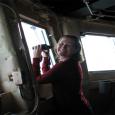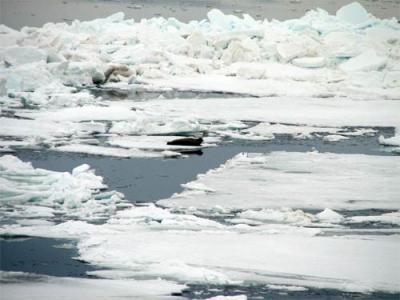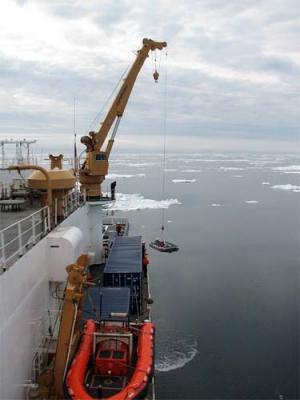Most people’s vision of "scientists” is men in white lab coats. On the Healy, the only people wearing white coats are the "seal team”—a group of four men and one woman from the National Marine Mammals Laboratory, based in Seattle, Washington. They are a very fun group to be around but then again, I’m biased as one of my first "off-ramps” in life was working with Pacific Walrus. So, anyone that works with Pinnipeds (seals and walrus) must be fun. We had a special treat yesterday and got to watch the seal team spring into action and head out to sea to catch seals.
Here are the members of the seal team. From left to right, Mike Cameron, Gavin Brady, Mike Apatiki (from Gambell), Shawn Dahle, and Erin Moreland (bottom right).
 Mike Cameron, lead researcher on the seal team.
Mike Cameron, lead researcher on the seal team.
 Gavin Brady, a member of the seal team.
Gavin Brady, a member of the seal team.
 Mike Apatiki, from Gambell, is a member of the seal team.
Mike Apatiki, from Gambell, is a member of the seal team.
 Shawn Dahle, member of the seal team, prepares the boat before deployment.
Shawn Dahle, member of the seal team, prepares the boat before deployment.
 Erin Moreland, member of the "seal team".
Erin Moreland, member of the "seal team".
The team, led by researcher Mike Cameron, has been aboard the Healy since her first trip into the Bering Sea as part of the BEST expedition. They are interested in seal populations, behaviors, and benthic ecology.
 Bearded Seal
Bearded Seal
*Bearded Seal that is just waiting to be captured by the seal team.
 Cool
Cool
One of the best techniques for gathering data about seals is to capture them and put satellite transmitters on the animals. The transmitters relay various types of information to a satellite when the seal is hauled out of the water and on the ice. This data is then transmitted to a computer far away from the Bering Sea. Once the data is analyzed (looked at), it will provide another piece of the puzzle in understanding the Northern Bering Sea ecosystem. The data from captured seals is also very important information for the people that live in the Bering Sea region as they depend on these animals for food.
 Preparing a satellite tag or transmitter that will be placed on a seal - if captured.
Preparing a satellite tag or transmitter that will be placed on a seal - if captured.
A satellite transmitter being prepared for placement on a seal - if captured.
 Perry Pungowiyi checks out the satellite tag for seals.
Perry Pungowiyi checks out the satellite tag for seals.
Perry Pungowiyi takes a closer look at a satellite tag.
Prior to Memorial Day, the team hadn’t been very busy due to the ice conditions – basically, there wasn’t any ice! Consequently, the four species of "ice” seals (Ribbon, Spotted, Ringed, and Bearded) – so called ice seals for their need to live on and around ice—haven’t been seen. Erin, the woman of the crew, has been keeping busy by knitting and reading and has made two scarves and read numerous novels ? Needless-to-say the group was VERY excited to be back in ice on Memorial Day. The only thing stopping them from boating out to the ice early in the morning was a Memorial Day BBQ on the helicopter deck.
 Memorial Day BBQ on the HELO deck (helicopter landing pad).
Memorial Day BBQ on the HELO deck (helicopter landing pad).
Memorial Day BBQ on the HELO deck (helicopter landing pad).
 Tom Bolmer and Marku Janout enjoying the BBQ.
Tom Bolmer and Marku Janout enjoying the BBQ.
Marcus Janout and Tom Bolmer enjoying their BBQ on the HELO deck.
After a good meal and being briefed on the bridge, the three boats were lowered into the ocean (which was an amazing thing to watch!) The seal team (all dressed in white hunting coats) climbed down a ladder off the port side (left side) of the ship and into their boats. Perry Pungowiyi, Bobby Ungwiluk, and Art Howard accompanied them as they boated out toward the ice to try and capture a seal.
 Boat being lowered to the water for seal capture work.
Boat being lowered to the water for seal capture work.
Boat being lowered by the crane into the water.
 Erin climbing back onboard the Healy via the ladder.
Erin climbing back onboard the Healy via the ladder.
Using the ladder to climb down to the boat below.
 One of the three seal team boats with Art Howard, Mike Apatiki, Bobby Unguwilk, and Perry Pungowiyi.
One of the three seal team boats with Art Howard, Mike Apatiki, Bobby Unguwilk, and Perry Pungowiyi.
Art Howard (person w/ camera), Perry Pungowiyi (driver), Bobby Ungwilik and Mike Apatiki wait for the other two boats to join them before heading off to capture seals.
After they departed, I spent the afternoon in the sun, watching the team from the bridge along with their spotter, Liz Labunski. Everyday, Liz spends her day on the bridge doing bird surveys for the U.S. Fish and Wildlife Service – so she is very familiar with being able to describe the ice and judge the distance to objects. Her job was to direct the boats towards the seals that were previously sighted from the bridge. It was a hard job but she was great and carefully directed the three boats towards seals. Unfortunately, after many splendid attempts to stalk up on seals (which turned out to be Bearded seals), the seal team never did capture a seal. They did hold a "mock” seal capture for the camera man – Art Howard – and captured him in the net on an ice floe ?
 The seal team boats in a group.
The seal team boats in a group.
The boats gather before heading out to the ice.
 A happy Erin Moreland - just returning from seal capture work.
A happy Erin Moreland - just returning from seal capture work.
Erin Moreland - very happy to have been out on the ice!
It was an amazing day and one that I won’t forget. If you’d like to see a movie about work on the Healy with some footage of the seal team, check out the Polar-Palooza website.
